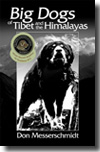| Our Publications | ||
| Books by Title | ||
| Books by Author | ||
| Books by Country | ||
| E-books | ||
| About | ||
| Orchid Press E-books | ||
| Distributed E-books | ||
| Our Bookshop | ||
| About Us | ||
| Browse Shop | ||
| How to Buy | ||
| Contact Us | ||
| WE BUY BOOKS AND LIBRARIES | ||
|
||
Book Reviews

Big Dogs of Tibet and the Himalayas
A Personal Journey
byDon Messerschmidt
2010, xiv, 268 pp., 40 b & w illustrations, 5 maps, bibliography, index, 23 x15 cm., softbound.
ISBN-13: 978-974-524-130-5 $29.50
The Italian Tibetan Mastiff Club
Review translated from the original Italian
Book review by Stafano Brovetto
(“http://www.clubitalianodelmastinotibetano.it/?page_id=383” Posted February 2011)
Softcover 270 pages, which contain a wealth of information, insights, quotes and reflections on the theme of the big dogs in the area of the Himalayas and Tibet Autonomous Region.
In this book the author describes his lifetime passion for large dogs, which led him to study and to carry out extensive research both in literature and in the field. He has traveled extensively in Nepal, Bhutan, India, Pakistan and Tibet.
The seven chapters in which the work is divided deal respectively with:
- The myth arising from the story of Marco Polo, criticized by the author based on well-substantiated considerations.
- The big dogs in the Himalayan Travelers’ Tales: scientists, missionaries, diplomats and mountaineers who went through the region over the centuries, from the eighteenth century until a few decades ago.
- Personal experiences of the author, his direct encounters with the dogs during his travels and excursions in Nepal and Tibet.
- The story of Saipal Baron of Emodus, aka ‘Kalu’, a Tibetan Mastiff that the author raised and has shown, that earned the title of International Champion, and some related travels.
- An extensive discussion on the Kyi Apso, sometimes called the “Bearded TM” (long-haired Tibetan Mastiff)
- Meeting different types of dogs while traveling through the Tibet Autonomous Region.
- Further reflections on the theme of myths and nonsense (about this breed), discussing and dismissing various notions including the definition of ‘dog’ and ‘breed’, among others.
To complete the work (the book includes) some appendices that reproduce some texts from other authors (including) ‘Dogs from the Roof of the World’, 1937, by Hon. Mrs. E. Bailey, and ‘Role of the Dog in Tibetan Nomadic Society’, 1963, by Robert Ekvall. (There is also) an interesting comparison that highlights how the main characters of the breed are defined by environmental conditions and (factors of natural and cultural) selection; (with) “natural” (Landrace) dogs compared with the “selected” (Purebred) dogs. And, finally a treatise on the genetics of coat color in the breed by Charles W. Radcliffe and Matthew J. Taylor, 2004-2008.
There is also a collection of study notes and a rich bibliography.
It’s important to note that the book, while clearly oriented to the theme of “Mastiff from the Himalayan area,” dwells on analyzing numerous variants present in the large area of Tibetan cultural influence, related breeds, but also completely different (big) dogs living in the same region, such as the Tibetan hunting dog, the “Sha-kyi.”
Reading the book is pleasant (and rather easily with a sufficient knowledge of English), although the illustrations are not present, frankly, as expected, but this is really one of the few criticisms that can be made.
In conclusion, we strongly recommend this book to a wide audience of readers, not just the enthusiastic owner of the Tibetan Mastiff, but also any big mountain dogs lover.
[Read a review from literarydog.com] [Read a review from Chowkidar Magazine] [Read a review from Amazon.com] [Read a review from ECS Nepal] [Read a review from Peace Corps Worldwide] Download an excerpt from the book, published in ECS Nepal. [More Orchid Press Reviews]
PO Box 70, Trinity TB, NL, A0C 2S0, Canada
Telephone: +1 709-330-4703